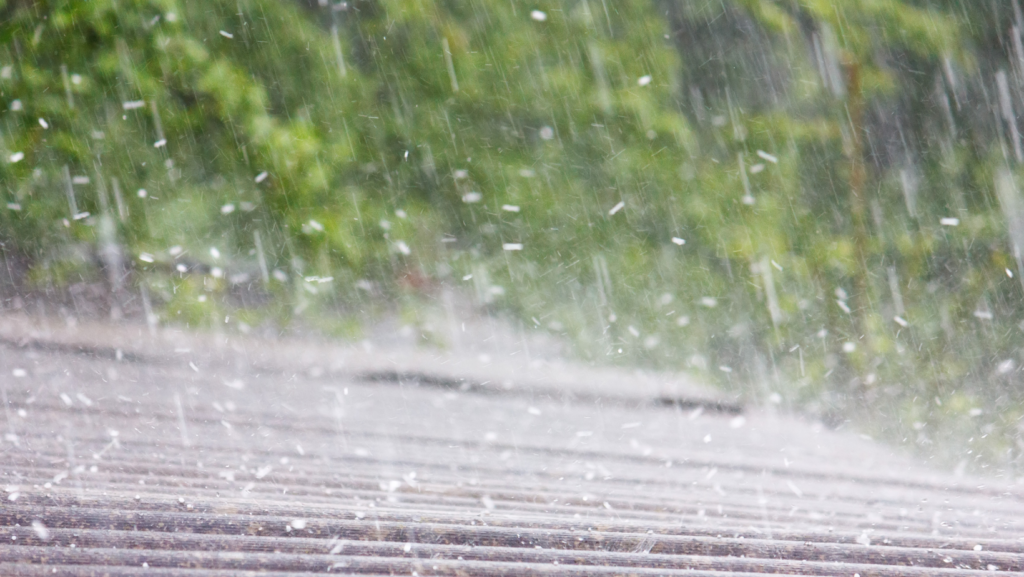If you have been unlucky enough to experience a hailstorm, you may be wondering what kind of damage it has done to your roof and how to fix them. Hail can cause significant damage to roofs, leaving homeowners with costly repairs.
From dents and cracks in the shingles to broken or missing tiles, if left untreated, it can lead to even more expensive repairs.
If you live in an area that is prone to hail, it is important to be aware of how to prepare for such calamity. In this article, we will discuss everything you need to know about hail damage and how to handle it.
What is Hail?
First, let us know a little more about hail. Hail is a form of solid precipitation that falls from the atmosphere in the form of balls or irregular lumps of ice. It most commonly occurs during thunderstorms, but can also fall during other severe weather conditions such as hurricanes and winter storms.
The diameter of hailstones can range from a few millimeters to several centimeters. The largest documented hailstone in the United States fell in South Dakota in 2010 and measured 8 inches in diameter.
How Does Hail Form?
Hailstones form when drops of water are carried high into the atmosphere and freeze. As these ice pellets fall, they are caught in updrafts and carried back up into the clouds. Here, they collect more water droplets and grow in size. The hailstones will continue to grow until they become too heavy to be carried by the updrafts and fall to the ground.
How Fast Does Hail Travel?
While most hailstones are small and cause little damage, larger ones can be extremely destructive, especially if they fall at high speeds. How fast they fall determines the amount of damage they can cause. Hailstones can fall at speeds of up to 100 miles per hour, which is strong enough to cause serious damage to property.
Common Hail Damages
Now that we know a little more about hail, let us discuss the damages it can cause. Hail can cause a lot of property damage, from dents on your car to cracked windows and, of course, roof damage.
Hailstones can break or crack shingles, causing water to seep into the home and cause further damage. It is crucial to have hail damage repaired as soon as possible to avoid any further or expensive repairs.
Specifically, roof damage receives the most damage from hailstorms. The most common type of hail damage is granule loss. Granules are the small, gravel-like stones on the top of shingles that protect them from ultraviolet rays. When these granules are lost, it exposes the asphalt beneath them to the elements and causes premature aging and deterioration.
In addition to granule loss, hailstorms can also cause cracks, dents, and gouges in shingles. These damages leave your roof vulnerable to leaks and water damage. Furthermore, missing or damaged shingles can also lead to wind damage which can cause even more damage to your roof.
Another type of roof damage that can be caused by hail is damage to the flashing. Flashing is the metal strips that are used to seal the gaps around chimneys, vents, and skylights. When hail hits these areas, it can dent or break the flashing which will then need to be repaired or replaced. Hail damage can also cause damage to gutters, downspouts, and other exterior features of your home.
How to Prepare for Hailstorms
The best way to deal with hail damage is to prevent it from happening in the first place. If you live in an area that is prone to hailstorms, there are some things you can do to prepare.
First, make sure your roof is in good condition and have any repairs done before the storm season. This will help minimize the amount of damage hail can do to your roof.
You should also clear any loose debris from your yard, such as leaves and branches, which can be picked up by high winds and cause additional damage. If a hailstorm is forecasted, you can also secure outdoor furniture and objects to prevent them from being blown around.
Finally, make sure you have a plan in place in case of an emergency, such as having a list of emergency contacts and knowing where to go if you need to evacuate your home.
Repairing Hail Damage To Roofs
If your home has suffered hail damage, it is important to have the repairs done as soon as possible. This will help prevent further damage and avoid any costly repairs.
There are a few different ways to repair hail damage, depending on the severity of the damage. For minor damages, such as dents and scratches, you may be able to repair the damage yourself. However, for more severe damages, such as cracked or missing shingles, you will need to hire a professional roofing contractor.
If you have hail damage that needs to be repaired, the first step is to call a roofing contractor for an inspection. They will be able to assess the damage and give you an estimate for repairs. In some cases, your insurance company may cover the cost of repairs, so it is important to check with them as well.
After the roofing contractor has repaired the damage, it is important to take measures to prevent future damage. This can be done by installing impact-resistant roofing materials or by retrofitting your home with hail guards. These devices help deflect hailstones from hitting your roof and causing damage.
—
A hailstorm is a severe weather condition that can cause a lot of damage, not just to your roof but to your entire home. It is important to be prepared for hailstorms and to have the damage repaired as soon as possible.
By taking these measures, you can help prevent further damage and keep your roof in good condition.


